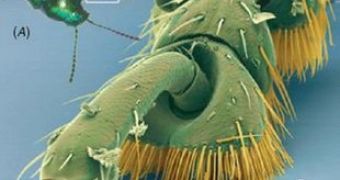Nature is well ahead man in what concerns the best technological patterns. That's why researchers are mimicking natural models to improve technologies.
Inspired by the microstructures of beetle feet, a team from the Max Planck Institute (MPI) in Stuttgart, Germany, and Case Western Reserve in Cleveland, US, has developed an "insect tape", a powerful sticky patterned adhesive, twice as sticky as flat tapes. The novel glue-free product adheres better to dusty surfaces, and can be re-employed multiple times after being washed with water and soap. Over 300 insect species were analyzed with the purpose of finding the best pattern for an artificial adhesive.
"This tape provides the highest stickiness among other tapes with reversible adhesion and remains sticky for the highest number of repetitions (several thousands of adhesion cycles)," co-author Stanislav Gorb of the MPI told PhysOrg.com. "After getting dirty, it can be washed with soapy water, and the initial stickiness will be recovered."
Insects display two types of adhesive feet surfaces: smooth pads (like in grasshoppers) and hairy surfaces (like in beetles). Hairy surfaces are made of dense hairs and setae, a few micrometers to several millimeters long. It appeared that a hierarchical pattern of hairs increases contact formation, and a high density of setae (shorter hairs) delivers an increased contact area, with increased adherence.
The "insect tape's" functionality is not affected by dust as gaps in the microstructures sink dust particles. Mushroom-shaped tips, encountered naturally on many insects' setae, adapt the tape to uneven surfaces and irregularities, like cracks. "The adhesive strength of insects, spiders, and geckos on smooth glass is in the range of 100 kPa [kilopascals, a measure of pressure]. Our material demonstrates about 60 kPa. We are not that far from them.", said Gorb.
The flexible fibers enable the use of the tape for many times. During the pull-off, the fibers are stretched by several micrometers to bypass the power keeping together the tape and substrate. This means that after hundreds of uses, the adhesive power lowers. The tape was checked with the glass-wall-climbing robot Mini-WhegsTM. When the 120-gram (4.2-ounce) robot's feet were fitted with the insect tape, this enabled the radio-controlled robot climbing glass walls.
The insect tape could be also used for optical lenses and CDs, and to stick objects on or protect sensitive glasses. Of course, the tape is still being tested and can be further improved. "It will be not as strong and as cheap as ScotchTM tape, but it will be reasonably cheap to use in everyday life. We believe that the tape will not replace existing tapes but find its applications in certain technological niches. Right now, most of applications are coming from high-tech companies, such as robotics and optical technologies.", said Gorb.

 14 DAY TRIAL //
14 DAY TRIAL //